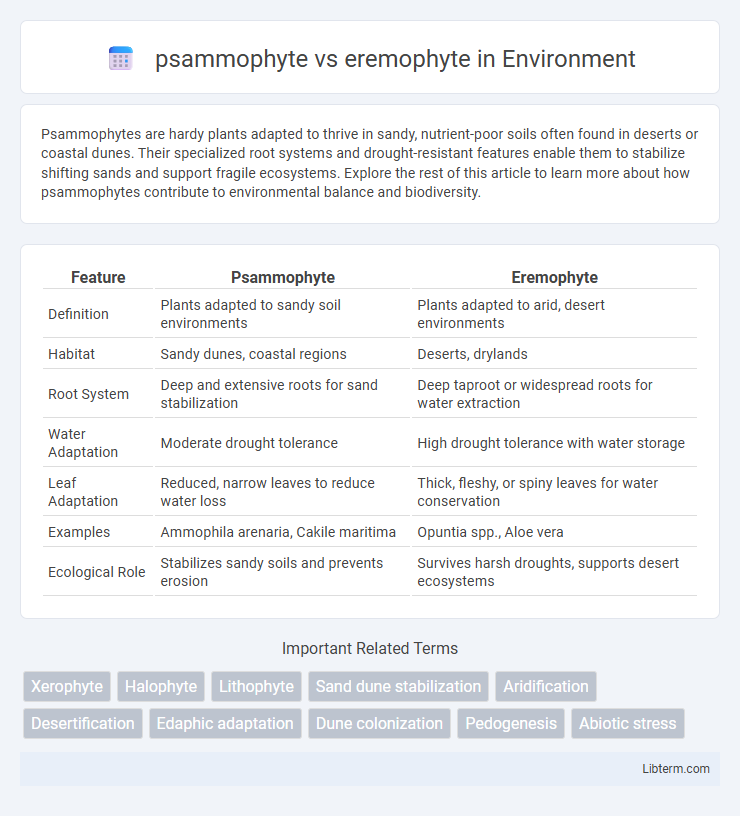Psammophytes are hardy plants adapted to thrive in sandy, nutrient-poor soils often found in deserts or coastal dunes. Their specialized root systems and drought-resistant features enable them to stabilize shifting sands and support fragile ecosystems. Explore the rest of this article to learn more about how psammophytes contribute to environmental balance and biodiversity.
Table of Comparison
| Feature | Psammophyte | Eremophyte |
|---|---|---|
| Definition | Plants adapted to sandy soil environments | Plants adapted to arid, desert environments |
| Habitat | Sandy dunes, coastal regions | Deserts, drylands |
| Root System | Deep and extensive roots for sand stabilization | Deep taproot or widespread roots for water extraction |
| Water Adaptation | Moderate drought tolerance | High drought tolerance with water storage |
| Leaf Adaptation | Reduced, narrow leaves to reduce water loss | Thick, fleshy, or spiny leaves for water conservation |
| Examples | Ammophila arenaria, Cakile maritima | Opuntia spp., Aloe vera |
| Ecological Role | Stabilizes sandy soils and prevents erosion | Survives harsh droughts, supports desert ecosystems |
Introduction to Psammophytes and Eremophytes
Psammophytes are specialized plants adapted to sandy environments, thriving in nutrient-poor, well-drained soils with high drought tolerance. Eremophytes are desert plants uniquely suited to arid conditions, exhibiting adaptations such as deep root systems and water storage tissues to survive extreme water scarcity. Both groups play crucial roles in ecosystem stability by preventing soil erosion and supporting biodiversity in harsh habitats.
Defining Psammophytes: Sand-Loving Plants
Psammophytes are specialized plants adapted to thrive in sandy environments, characterized by their ability to stabilize shifting sand dunes and tolerate low nutrient availability. These sand-loving plants possess deep root systems that anchor them firmly in loose substrates and conserve water efficiently to survive arid conditions. Unlike eremophytes, which are adapted to desert habitats with extreme heat and drought, psammophytes specifically colonize sandy soils, playing a crucial role in preventing desertification and supporting fragile ecosystems.
Eremophytes Explained: Masters of Arid Environments
Eremophytes thrive in extreme arid environments by developing specialized adaptations such as deep root systems, reduced leaf surface area, and water-storing tissues to conserve moisture. These plants exhibit remarkable drought resistance, enabling survival in deserts with minimal rainfall and high soil salinity. Their physiological mechanisms, like CAM photosynthesis and stomatal control, optimize water use efficiency, distinguishing them from psammophytes that primarily adapt to sandy soils rather than extreme dryness.
Key Differences Between Psammophytes and Eremophytes
Psammophytes are plants adapted to sandy soils with high permeability and low water retention, often found in coastal dunes and desert margins, characterized by deep root systems and tolerance to salt spray. Eremophytes thrive specifically in arid desert environments with extreme water scarcity, featuring adaptations like reduced leaf area and water storage tissues to minimize transpiration and maximize water retention. Key differences include their habitat preferences--psammophytes dominate sandy substrates with occasional moisture, while eremophytes occupy hyper-arid zones--and their physiological adaptations geared toward soil type and water availability.
Ecological Roles and Adaptations
Psammophytes and eremophytes exhibit distinct ecological roles and adaptations tailored to their habitats; psammophytes thrive in sandy soils, stabilizing dunes with deep root systems that prevent erosion. Eremophytes adapt to arid desert conditions by developing water storage tissues and minimizing transpiration through features like thick cuticles and reduced leaf surfaces. Both plant groups contribute to ecosystem stability, with psammophytes fostering soil retention and eremophytes supporting survival in extreme drought environments.
Morphological Characteristics Comparison
Psammophytes exhibit specialized root systems with extensive branching to anchor in sandy soils, while eremophytes often develop deep taproots to access water in arid environments. Leaf morphology differs significantly, as psammophytes possess narrow, tough leaves to reduce water loss, whereas eremophytes commonly have succulent or reduced leaves for water storage and minimizing transpiration. Both plant types display adaptations like thick cuticles and trichomes, but these features vary in density and structure according to their distinct ecological niches.
Geographic Distribution and Habitat Preferences
Psammophytes primarily thrive in sandy soil environments found in coastal dunes, deserts, and riverbanks, favoring areas with loose, well-drained substrates and low nutrient availability. Eremophytes, on the other hand, are adapted to arid and semi-arid desert regions, exhibiting tolerance to extreme drought conditions and high temperature fluctuations commonly seen in desert steppes and rocky terrains. Geographic distribution of psammophytes includes temperate and subtropical zones with sandy habitats, whereas eremophytes are predominantly found in xeric zones such as the Sahara, Sonoran, and Arabian deserts.
Importance in Ecosystem Stability
Psammophytes, specialized plants adapted to sandy soils, play a crucial role in stabilizing dunes and preventing soil erosion in arid and semi-arid ecosystems. Eremophytes, adapted to extreme desert conditions, contribute to ecosystem stability by enhancing soil fertility and providing habitat for desert fauna, thus maintaining biodiversity. Both plant types are essential for sustaining fragile desert ecosystems by supporting nutrient cycles and protecting against land degradation.
Notable Examples of Psammophytes and Eremophytes
Notable examples of psammophytes include Ammophila arenaria (marram grass), which stabilizes coastal sand dunes, and Corynephorus canescens, adapted to sandy soils with minimal water. Prominent eremophytes such as Larrea tridentata (creosote bush) and Acacia tortilis thrive in arid desert environments, exhibiting adaptations like deep root systems and drought-resistant leaves. These species demonstrate specialized survival mechanisms tailored to either sandy substrates or extreme dry conditions.
Implications for Conservation and Restoration Ecology
Psammophytes, adapted to sandy soils with traits such as deep root systems and drought resistance, play a critical role in stabilizing shifting sand dunes and maintaining fragile desert ecosystems. Eremophytes, specialized for extreme arid conditions with mechanisms like water storage and reduced leaf surface area, contribute to biodiversity in hyper-arid regions and serve as indicators of ecosystem health. Understanding the ecological functions and adaptive strategies of both psammophytes and eremophytes guides effective conservation planning and restoration projects by promoting species selection that enhances habitat resilience and soil stabilization in desert and semi-desert landscapes.
psammophyte Infographic

 libterm.com
libterm.com